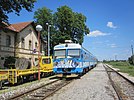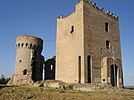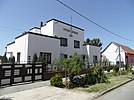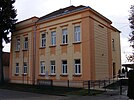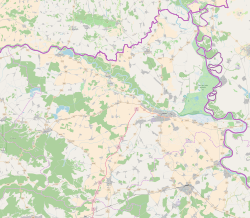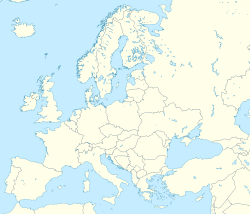Erdut (Serbian Cyrillic: Ердут, [ěrduːt]) is a village and a municipality in eastern Croatia some 37 km east of the major city of Osijek. Lying on the border with neighbouring Serbia, it was the site of the signing of the 1995 Erdut Agreement, which initiated the UNTAES transitional administration over the Eastern Slavonia, Baranja and Western Syrmia.
Erdut
| |
|---|---|
| Municipality of Erdut Općina Erdut Општина Ердут | |
Villages of the Erdut Municipality | |
| Coordinates: 45°32′N 19°04′E / 45.533°N 19.067°E | |
| Country | |
| Region | Slavonia (Podunavlje) |
| County | |
| Municipal seat Largest settlement | Erdut (nominal), Dalj (administrative) Dalj |
| Government | |
| • Municipal mayor | Jugoslav Vesić (SDSS) |
| Area | |
| 157.5 km2 (60.8 sq mi) | |
| • Urban | 30.5 km2 (11.8 sq mi) |
| Elevation | 158 m (518 ft) |
| Population (2021)[3] | |
| 5,436 | |
| • Density | 35/km2 (89/sq mi) |
| • Urban | 561 |
| • Urban density | 18/km2 (48/sq mi) |
| Time zone | UTC+1 (CET) |
| • Summer (DST) | UTC+2 (CEST) |
| Postal codes | |
| Area code | 031 |
| Official languages | Croatian, Serbian[1] |
| Website | opcina-erdut |
The village of Erdut is the third largest in the municipality, after Dalj and Bijelo Brdo. The municipality is part of the Osijek-Baranja County in eastern Slavonia. The municipal center is in the largest village of Dalj.
Name and languages
editThe name Erdut comes from the local Hungarian name (Erdőd) meaning "forest road".[4] In other languages, the village in German is known as Erdung and in Serbian as Ердут.
Due to the local minority population, the Erdut municipality prescribe the use of not only Croatian as the official language, but the Serbian language and Serbian Cyrillic alphabet as well.[5]
Geography
editThe municipality has a total area of 158 km2[6] (61 sq mi) and is the largest member municipality of Joint Council of Municipalities. The Drava (5.6 km[6]) and Danube (34.825 km[6]) rivers flow through the municipality. The territory of the municipality is completely flat very fertile black soil. The elevation of the village of Erdut is 158 m. It is located at the end of the D213 road near border crossing with Serbia. The railway station is located in Novi Erdut (New Erdut) hamlet, about 1 km south of the village, on the Vukovar-Erdut-Bogojevo (Serbia) railway.
History
editThe settlement was first mentioned in 1335 under the Hungarian name Erdöd and then as a city in 1472.[4] It was successively ruled by Ottoman Empire, Austrian Empire, Austria-Hungary, Kingdom of Yugoslavia, Independent State of Croatia and Yugoslavia.
Croatian War of Independence
editWhen Croatia declared independence from Yugoslavia in 1991, eastern Slavonia was soon overrun by the Yugoslav People's Army and Serb paramilitaries, led by the notorious warlord, Željko Ražnatović known by the name Arkan.[7] The battle for Erdut quickly ended that summer as the entire Croatian population was expelled or killed along with other minorities including Czechs, Germans, Hungarians, Ruthenians and Ukrainians in an act of ethnic cleansing.[8] Their homes were soon occupied by other Serbs.[8] Many buildings and homes were destroyed, including the Roman Catholic Church.[8]
Arkan soon set up a training camp for his Serb Volunteer Guard in Erdut, which became headquarters until the end of the war, when Croatian forces returned according to a peaceful Basic Agreement on the Region of Eastern Slavonia, Baranja and Western Sirmium.
Erdut Agreement
editOn November 12, 1995, officials signed what is commonly called the Erdut Agreement[9] in which the part of eastern Slavonia still occupied by Serbs would be integrated back into Croatia, gradually allowing some of the exiled refugees to return to their homes. This agreement was the basis for the establishment of Joint Council of Municipalities.[9] Erdut has been under Croatian control since 1998.[10]
Demographics
edit| Year | Pop. | ±% |
|---|---|---|
| 1880 | 9,421 | — |
| 1890 | 10,451 | +10.9% |
| 1900 | 10,904 | +4.3% |
| 1910 | 11,373 | +4.3% |
| 1921 | 10,543 | −7.3% |
| 1931 | 10,976 | +4.1% |
| 1948 | 10,177 | −7.3% |
| 1953 | 10,324 | +1.4% |
| 1961 | 11,440 | +10.8% |
| 1971 | 11,353 | −0.8% |
| 1981 | 11,035 | −2.8% |
| 1991 | 10,197 | −7.6% |
| 2001 | 8,417 | −17.5% |
| 2011 | 7,308 | −13.2% |
| Source: Naselja i stanovništvo Republike Hrvatske 1857–2001, DZS, Zagreb, 2005 | ||
Population
editAccording to the 2011 census, the municipality has a population is 7,308. The municipal population consists of Serbs (55,56%), Croats (37,96%) and Hungarians (5,06%).[11]
There are 4 settlements in municipality:[12]
| Settlement | population |
|---|---|
| Aljmaš | 610 |
| Bijelo Brdo | 1,976 |
| Dalj | 3,952 |
| Erdut | 818 |
Religion
editDalj is seat of the Eparchy of Osječko polje and Baranja of the Serbian Orthodox Church.
Politics
editJoint Council of Municipalities
editThe Municipality of Erdut is one of seven Serb majority member municipalities within the Joint Council of Municipalities, inter-municipal sui generis organization of ethnic Serb community in eastern Croatia established on the basis of Erdut Agreement. As Serb community constitute majority of the population of the municipality it is represented by 2 delegated Councillors at the Assembly of the Joint Council of Municipalities, double the number of Councilors to the number from Serb minority municipalities in Eastern Croatia.[13]
Municipal government
editThe municipality assembly is composed of 13 representatives. As of 2021, the member parties are:[14]
| Party | Number of votes | Number of seats | |
|---|---|---|---|
| Independent Democratic Serb Party | 1.205 | 8 | |
| Croatian Democratic Union | 698 | 4 | |
| Workers' Front | 141 | 1 |
Minority councils
editDirectly elected minority councils and representatives are tasked with consulting the local or regional authorities, advocating for minority rights and interests, integration into public life and participation in the management of local affairs.[15] At the 2023 Croatian national minorities councils and representatives elections Hungarians and Serbs of Croatia each fulfilled legal requirements to elect 10 members municipal minority councils of the Erdut Municipality.[16]
Economy
editErdut development index is between 50 and 76% of the Croatian average,[17] and is underdeveloped municipality which is statistically classified as the First Category Area of Special State Concern by the Government of Croatia.[18]
Culture
editThis section is written like a travel guide. (March 2014) |
Points of Interest
editThe municipality is home of Eparchy of Osječko polje and Baranja, and there is also Erdut Castle.
Notable natives and residents
edit- Milutin Milanković, born in Dalj
- Anton Tittjung, World War II concentration camp guard, who was stripped of his U.S. citizenship for his wartime activities.
See also
editReferences
edit- ^ a b Government of Croatia (October 2013). "Peto izvješće Republike Hrvatske o primjeni Europske povelje o regionalnim ili manjinskim jezicima" (PDF) (in Croatian). Council of Europe. p. 36. Retrieved 30 November 2016.
- ^ Register of spatial units of the State Geodetic Administration of the Republic of Croatia. Wikidata Q119585703.
- ^ "Population by Age and Sex, by Settlements" (xlsx). Census of Population, Households and Dwellings in 2021. Zagreb: Croatian Bureau of Statistics. 2022.
- ^ a b "Erdut | Općina Erdut". Opcina-erdut.hr. Retrieved 2014-01-31.
- ^ Izvješće o provođenju ustavnog zakona o pravima nacionalnih manjina i o utošku sredstava osiguranih u državnom proračunu Republike Hrvatske za 2008. godinu za potrebe nacionalnih manjina, Zagreb, 2009.
- ^ a b c "Povrsina, stanovnistvo, naseljenost" (PDF). Opcina-erdut.hr. Archived from the original (PDF) on 2013-06-22. Retrieved 2014-02-21.
- ^ "Transcript". Slobodan-milosevic.org. 2004-01-13. Retrieved 2014-01-31.
- ^ a b c The New York Times; May 10, 1992
- ^ a b "Peace Agreements Digital Collection" (PDF). Usip.org. Archived from the original (PDF) on 2013-02-01. Retrieved 2014-02-21.
- ^ "The Thorny Issue of Ethnic Autonomy in Croatia" (PDF). Ecmi.de. Archived from the original (PDF) on 2011-03-02. Retrieved 2014-02-21.
- ^ "Population by Ethnicity, by Towns/Municipalities, 2011 Census: County of Osijek-Baranja". Census of Population, Households and Dwellings 2011. Zagreb: Croatian Bureau of Statistics. December 2012.
- ^ "Population by Age and Sex, by Settlements, 2011 Census: Erdut". Census of Population, Households and Dwellings 2011. Zagreb: Croatian Bureau of Statistics. December 2012.
- ^ "Konstituisan 6. saziv Zajedničkog veća opština l" (in Serbian). Zagreb: Privrednik. 1 August 2017.
- ^ "Konačni rezultati lokalnih izbora 2021 na području općine Erdut". 2021-05-19. Retrieved 2021-06-09.
- ^ "Manjinski izbori prve nedjelje u svibnju, kreću i edukacije". T-portal. 13 March 2023. Retrieved 2 May 2023.
- ^ "Informacija o konačnim rezultatima izbora članova vijeća i izbora predstavnika nacionalnih manjina 2023. XIV. OSJEČKO-BARANJSKA ŽUPANIJA" (PDF) (in Croatian). Državno izborno povjerenstvo Republike Hrvatske. 2023. p. 26. Archived from the original (PDF) on 3 June 2023. Retrieved 3 June 2023.
- ^ "Odluka o razvrstavanju jedinica lokalne i područne (regionalne) samouprave prema stupnju razvijenosti" (in Croatian). 27 December 2013. Retrieved 12 October 2015.
- ^ Lovrinčević, Željko; Davor, Mikulić; Budak, Jelena (June 2004). "AREAS OF SPECIAL STATE CONCERN IN CROATIA- REGIONAL DEVELOPMENT DIFFERENCES AND THE DEMOGRAPHIC AND EDUCATIONAL CHARACTERISTICS". Ekonomski pregled, Vol.55 No.5-6. Archived from the original on 18 August 2018. Retrieved 25 August 2018.
External links
edit- Official website (in Croatian)

